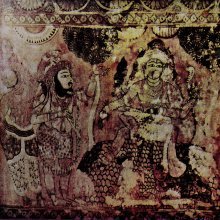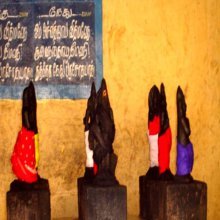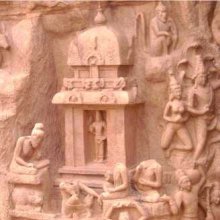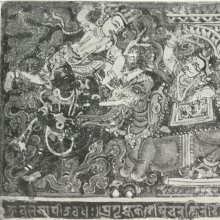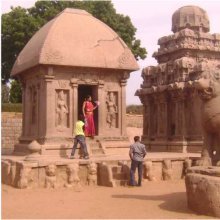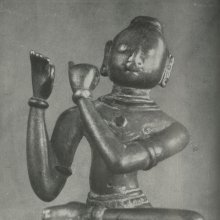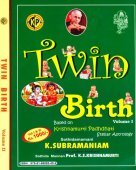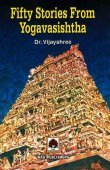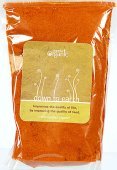Life: 2 definitions
Introduction:
Life means something in Hinduism, Sanskrit, the history of ancient India. If you want to know the exact meaning, history, etymology or English translation of this term then check out the descriptions on this page. Add your comment or reference to a book if you want to contribute to this summary article.
Images (photo gallery)
(+79 more images available)
In Hinduism
Yoga (school of philosophy)
Source: ORA: Amanaska (king of all yogas): A Critical Edition and Annotated Translation by Jason BirchLife (i.e., “that state of being alive”) is denoted by the Sanskrit term Jīvita, according to the Yogatārāvalī: a short Yoga text of twenty-nine verses presenting Haṭhayoga as the means to Rājayoga (i.e., Samādhi).—Accordingly, while describing the states of waking, sleep, life and death: “For those [Yogins] situated in [the state of] Rājayoga whose gaze is free from all sense objects, here there is no waking, no state of sleep, no life (jīvita), no death and no mind”.

Yoga is originally considered a branch of Hindu philosophy (astika), but both ancient and modern Yoga combine the physical, mental and spiritual. Yoga teaches various physical techniques also known as āsanas (postures), used for various purposes (eg., meditation, contemplation, relaxation).
India history and geography
Source: Suomen Antropologi: Sacred Trees among the Tamil people of South IndiaFor the Hindus all life is sacred. The divine soul is believed to permeate all that exists in nature: stones, plants, animals and humans. [...] Before the Vedic period, forests were experienced as the home of wild forces of animal and vegetative life, beyond the control of village life guided by the priests. A division was perceived between orderly village life controlled by the Brahmins (priests) who guided the people in the practice of dharma (the cosmic law that refers to the duty of human beings to their family, to society, humanity, nature and towards God), and the adharmic world of the forests (that which is not in accord with the law of dharma) over which the priests had no control. The Brahmins were seen as the transformers of the forces between men and gods, heaven and earth that have been awakened by the power of ritual sacrifices.

The history of India traces the identification of countries, villages, towns and other regions of India, as well as mythology, zoology, royal dynasties, rulers, tribes, local festivities and traditions and regional languages. Ancient India enjoyed religious freedom and encourages the path of Dharma, a concept common to Buddhism, Hinduism, and Jainism.
See also (Relevant definitions)
Starts with: Life Infatuation, Life leaf, Life plant, Life-everlasting.
Ends with: Animal life, Awakolife, Chaste Life, Flife, Fluid Of Life, Fruits Of Monk Life, Human life, Leaf of life, Past life, Spiritual life, Tamil life, Tree of life, Tree of success in life, Way of life.
Full-text (+10246): Jivita, Jiva, Prana, Ayus, Vanaprastha, Ashrama, Ayushya, Jivana, Purvajanman, Brahmacarya, Jataka, Jivitasa, Dvyayusha, Moksha, Jivitesha, Hayata, Yavajjiva, Samsara, Janman, Jivaka.
Relevant text
Search found 556 books and stories containing Life; (plurals include: Lives). You can also click to the full overview containing English textual excerpts. Below are direct links for the most relevant articles:
The Garuda Purana (by Manmatha Nath Dutt)
Chapter LXIII - A brief discourse on the auspicious and inauspicious marks on the persons of males < [Agastya Samhita]
Chapter CVIII - Synopsis of rules of conduct < [Brihaspati (Nitisara) Samhita]
Chapter LXV - Auspicious marks on men and women as disclosed by the science of Samudrikam < [Agastya Samhita]
Yoga Vasistha [English], Volume 1-4 (by Vihari-Lala Mitra)
Chapter XIV - Depreciation of human life < [Book I - Vairagya khanda (vairagya khanda)]
Chapter LXII - Speech of the divine messenger < [Book IV - Sthiti prakarana (sthiti prakarana)]
Chapter LXXVII - Deliberation of karkati < [Book III - Utpatti khanda (utpatti khanda)]
Bhagavati-sutra (Viyaha-pannatti) (by K. C. Lalwani)
Part 3 - Last life of a devotee < [Chapter 10]
Chapter 6: Council of Śakrendra < [Book 10]
Part 21 - On the course of life of the non-restrained < [Chapter 1]
Yoga-sutras (with Vyasa and Vachaspati Mishra) (by Rama Prasada)
Sūtra 2.13 < [Book 2 - Practice (Sādhana)]
Sūtra 2.34 < [Book 2 - Practice (Sādhana)]
Sūtra 2.12 < [Book 2 - Practice (Sādhana)]
Complete works of Swami Abhedananda (by Swami Prajnanananda)
Chapter 3 - Law of Compensation < [Discourse 4 - Doctrine of Karma]
Chapter 1 - Reincarnation < [Discourse 3 - Reincarnation]
Chapter 6 - Ethics of Hinduism and Buddhism < [Discourse 7 - Thoughts on Sankhya Buddhism and Vedanta]
The Great Chronicle of Buddhas (by Ven. Mingun Sayadaw)
Supplement (a): Brief Statement of Future Buddha Gotama’s Live < [Chapter 9 - The chronicle of twenty-four Buddhas]
Fourteen Kinds of Gift to Individuals < [Chapter 6 - On Pāramitā]
Chapter 4 - The Renunciation of Sumedha < [The Anudīpanī (on the Great Chronicle of Buddhas)]
Related products
(+161 more products available)
